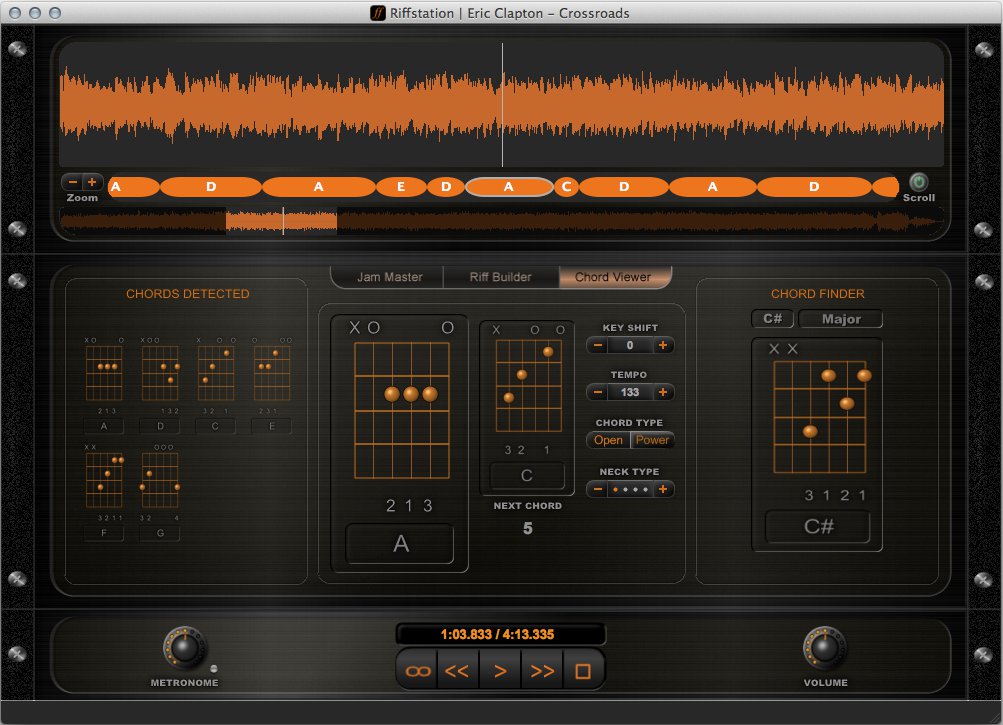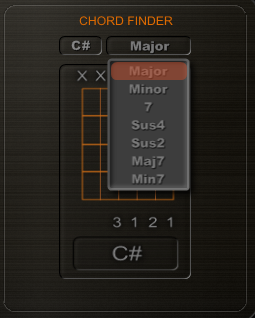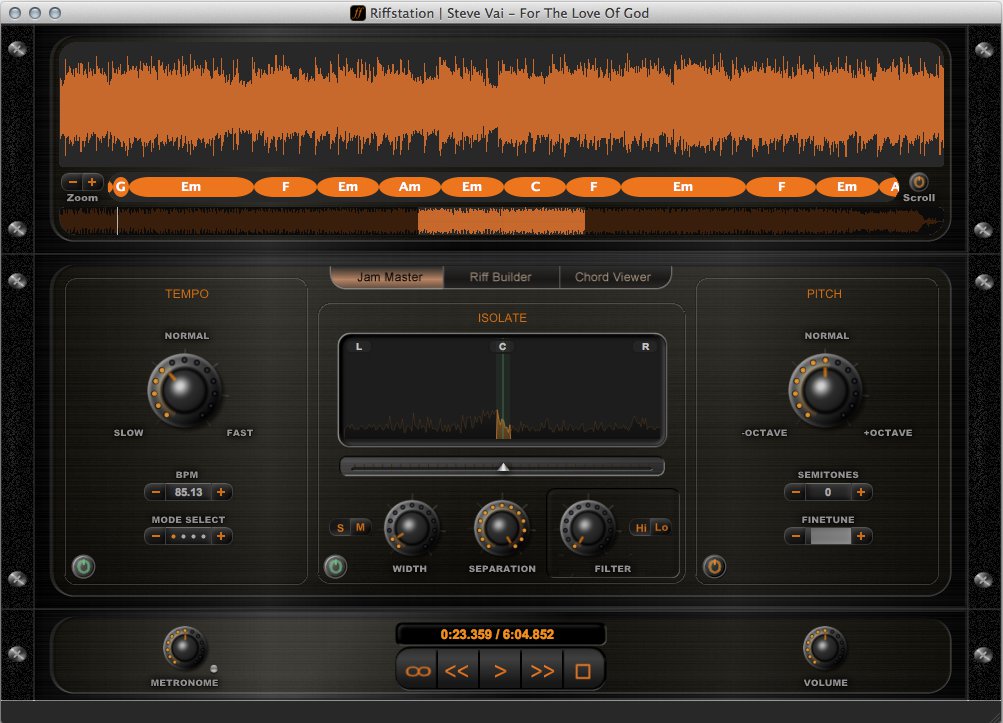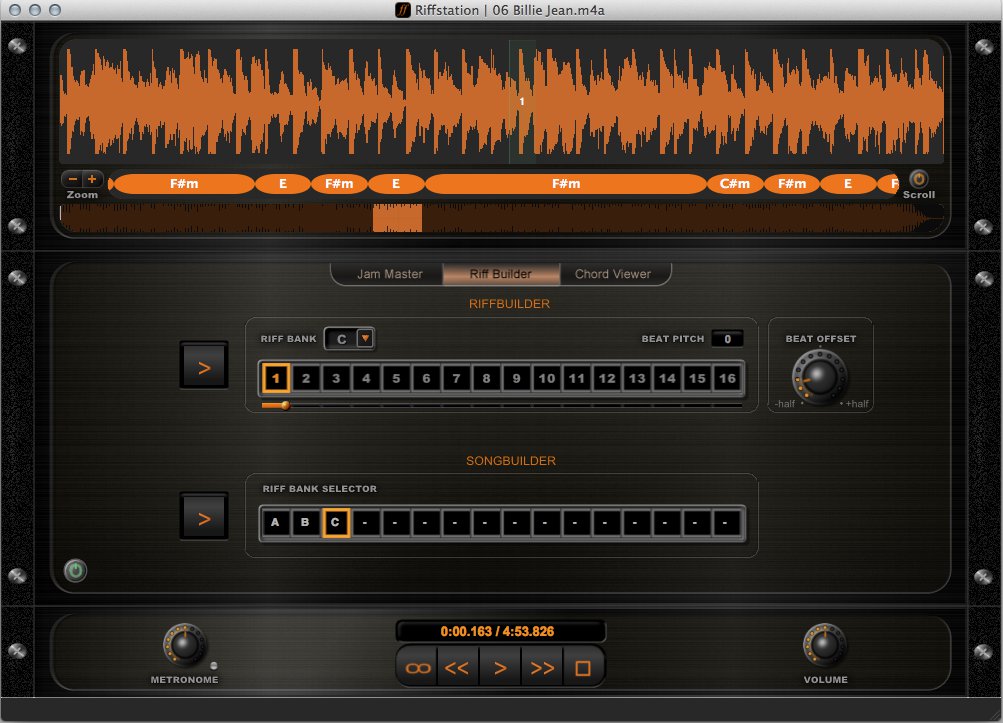Riffstation is a piece of software for Mac and PC aimed at practicing guitarists – as in guitarists who actually spend time practicing their instrument instead of wasting their time collecting various pieces of gear in an endless quest for “the tone” ™.
Learning and jamming along your favorite songs is a very effective way to practice new licks or techniques, and Riffstation is a toolbox enabling you to make this process more effective. It is composed of three main screens which I will detail in this post.
Chord Detection
The first screen is dedicated to chord detection. You load up an MP3 – it works with M4As as well – in Riffstation, it thinks for a little while and displays the chords alongside the waveform of the song! It sounds a bit miraculous – and it is – but it is limited to basic chords, no seventh, ninth or B7sus2#4Aug9.
It works pretty well I must say, and saves a lot of time in case you need to quickly learn a new song and you don’t have access to the tab or the score. In case of complex chords, it will try to find the nearest “basic” one. With that in mind, it is understandable that I had better results with simpler rock songs than lydian-locrian Steve Vai-esque stuff.

A nice addition to the chord viewer is the chord finder which will show you the fingering for a number of common (and not so common) chords. It does not cover everything but it’s nice to have:

Jam Master
The Jam Master screen is dedicated to audio manipulations to help you jam along the song currently loaded in Riffstation’s memory: you can “mask” the lead guitar to replace it with your own performance, or on the contrary “isolate” the lead guitar to better work out those tricky licks.
I guess it works like Karaoke software and uses a combination of spatial placement and frequencies to extract the lead guitar out the mix. You can tweak the width of the “cancellation” or “isolation” as well as use a filter (hi-pass ou low-pass) in order to zone in on the exact frequency of the guitar. Furthermore, since the instrument you are trying to cancel or isolate might not be mixed in the center of the stereo image, Riffstation lets you choose where in the stereo space you want to isolate or cancel.

You can also alter the tempo (as in the “speed” of the song) without changing the pitch. Combined with the “isolation” function, it helps analyzing fast licks: now you have no excuse not to play like Yngwie! If you want to change the pitch without changing the tempo (transpose), it is also possible which is very handy if you need to play a song in a different key from the original. It often happens if the singer in your band has a different register to the original. On a side note, I could not resist loading Roxane and make Sting sounds like he had a whiff of Helium, it never gets old.
Finally, Riffstation detects the tempo and the “bars”, which allows for efficient looping in case you want to practice and practice… and practice just a few bars.
Riff Builder
Riffstations’s third and last screen, Riff Builder, is a bit “out there”. The idea is that you can cut the song currently loaded in memory into splices and rearrange them to create new “arrangements” on the fly.
The process starts with building a “riff” bank which can contain up to 16 riffs. Each of these riffs consists of one or several bars cut out from the current song.

You can then create a song made up by a selection of those riffs. I think it’s actually useful if you want to jam to certain parts of a song but not all of the parts, or if you want to try out new arrangements for an existing song. Although I think it could have a little more features and be a bit more intuitive, the Riff Builder is a worthy addition to Riffstation.
Note that the riffs and songs built with the Riff Builder can be exported to wave files for use in other software or machines.
Conclusion
Riffstation has a sleek look and is easy and fast to operate. As such, its competition is rather found in hardware “jam companions”, such as those produced by a famous Japanese company, than in other pieces of software. Tested on an old-ish Macbook pro, I found it to be fast and stable. It only costs Eur 39.99 which is very reasonable, especially in comparison to the amount of dough we drop on gear. A small price to pay to become a better guitarist – even advanced guitarists can benefit from it. I suggest you go and download your 30 day trial version to get an idea of what it can do for you.

You can also do much of the same things with the very free and functional Audacity if you’re a cheapo like me.
Hello, I am a singer/songwriter who has experimented with many slow-downers over the years, and the best one I have found to date is Song Surgeon software. Although Riffstation offers good quality, Song Surgeon is much more sophisticated in what it can do and offers a variety of extra features. See my website to compare slow-down software. Thanks!
Thank you for the tip.